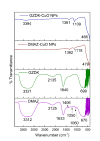Biosynthesis of CuO nanoparticle using leaf extracts of Ocimum lamiifolium Hochst. ex Benth and Withana somnifera (L) Dunal for antibacterial activity
- PMID: 39396068
- PMCID: PMC11470964
- DOI: 10.1038/s41598-024-75296-2
Biosynthesis of CuO nanoparticle using leaf extracts of Ocimum lamiifolium Hochst. ex Benth and Withana somnifera (L) Dunal for antibacterial activity
Erratum in
-
Publisher Correction: Biosynthesis of CuO nanoparticle using leaf extracts of Ocimum lamiifolium Hochst. ex Benth and Withana somnifera (L) Dunal for antibacterial activity.Sci Rep. 2025 May 12;15(1):16452. doi: 10.1038/s41598-025-98002-2. Sci Rep. 2025. PMID: 40355576 Free PMC article. No abstract available.
Abstract
Nanotechnology is becoming a promise for scientific advancement nowadays in areas like medicine, consumer products, energy, materials, and manufacturing. Copper oxide nanoparticles (CuO NPs) were synthesized using Ocimum lamiifolium Hochst. ex Benth and Withana somnifera (L) Dunal leaf extract via green synthetic pathway. The leaf of O. lamiifolium and W. somnifera were known to have strong antibiotic and antioxidant properties arising due to the presence of various secondary metabolites, including, flavonoids, alkaloids, saponins, tannins, cardiac glycosides, and phenolic compounds which serve as reducing, stabilizing, and capping agents for the CuO-Nanoparticles (NPs) synthesized. The biosynthesized CuO NPs were characterized based on Fourier transform infrared spectroscopy, X-ray diffraction spectroscopy, and scanning electron microscopy. O. lamiifolium and W. somnifera leaf extract mediated synthesis could produce CuO NPs with average crystallite size of 15 nm and 19 nm, respectively. The biosynthesized CuO-NPs were further examined for antibacterial activity with Gram-positive (S. aureus) and Gram-negative bacteria (E. coli and P. aeruginosa). The GZDK-CuO NPs synthesized using W. somnifera leaf extract inhibited the growth of E. coli. and P. aeruginosa largely in comparison to S. aureus. Whereas the DMAZ-CuO NPs synthesized with the help of O. lamiifolium leaf extract showed higher bacterial inhibition on E. coli compared to S. aureus and P. aeruginosa. The minimum inhibitory concentration (MIC) values of both types of NPs are also assessed on all three pathogens. The newly biosynthesized nanoparticles, thus, were found to be optional materials for inhibiting the growth of drug- resistant bacterial pathogens.
Keywords: Antibacterial activity; Green synthesis; Nanotechnology; Phytochemicals.
© 2024. The Author(s).
Conflict of interest statement
The authors declare no competing interests.
Figures








References
-
- Barzinjy, A. A., Hamad, S. M., Aydın, S., Ahmed, M. H. & Hussain, F. H. S. Green and eco-friendly synthesis of nickel oxide nanoparticles and its photocatalytic activity for methyl orange degradation. J. Mater. Sci.: Mater. Electron.31, 11303–11316 (2020).
MeSH terms
Substances
LinkOut - more resources
Full Text Sources
Medical

